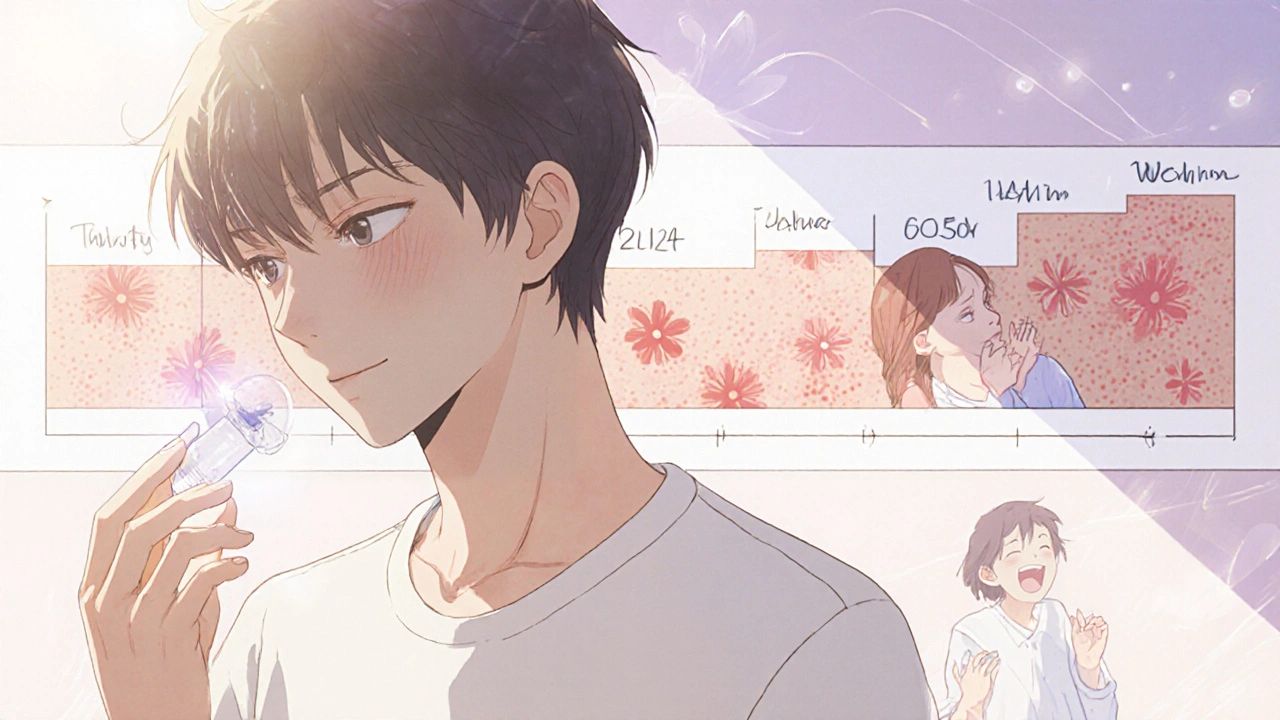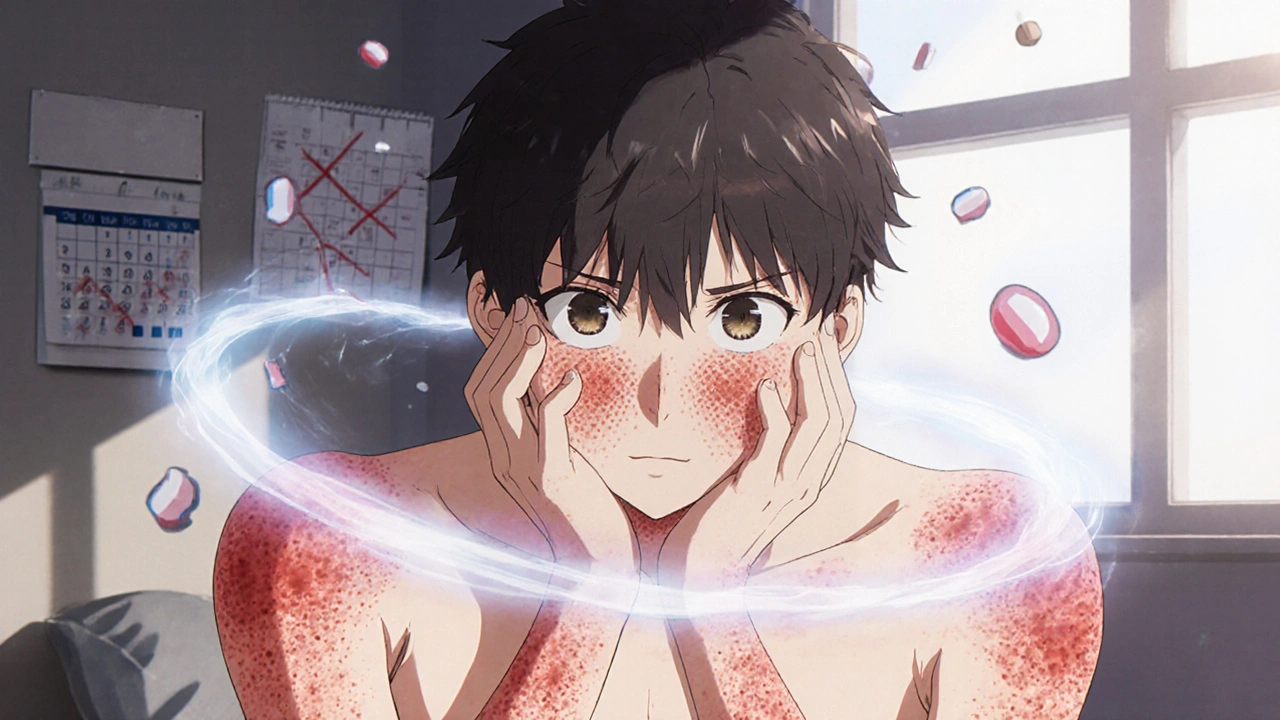When your skin breaks out in raised, itchy welts-or worse, your lips or throat swell up suddenly-you’re not just dealing with discomfort. You’re facing urticaria and possibly angioedema, two conditions that can turn a normal day into a medical emergency. The good news? Most cases are treatable. The catch? Not all treatments work the same way, and using the wrong one can waste time, delay recovery, or even put you at risk.
What’s the Difference Between Hives and Angioedema?
Hives (urticaria) are red, itchy, raised bumps on the skin that come and go within hours. They can appear anywhere-on your arms, stomach, face, or even inside your mouth. Angioedema is deeper swelling, usually under the skin around the eyes, lips, tongue, hands, or feet. Sometimes, it affects the throat or airway, which is dangerous.
These two often happen together, but they don’t always. About 10-20% of people with hives also get angioedema. The key difference? Hives itch. Angioedema usually doesn’t. If your lips swell but don’t itch, it’s likely not histamine-driven-and that changes everything about how you treat it.
Acute vs. Chronic: Timing Matters
Urticaria and angioedema are split into two categories based on how long they last:
- Acute: Lasts less than six weeks. Often caused by something clear-like a food allergy, medication (especially ACE inhibitors), insect sting, or infection.
- Chronic: Lasts more than six weeks. In most cases, no clear trigger is found. This is called chronic spontaneous urticaria (CSU) and affects about 1% of people at some point.
Chronic hives aren’t usually caused by allergies. Despite what many believe, food allergies rarely cause hives that last for months. Instead, your immune system may be overreacting for no obvious reason. The body releases histamine from mast cells, causing swelling and itching-but why? That’s still unclear in most cases.
First-Line Treatment: Antihistamines Are Key
For both acute and chronic hives, the first and most important treatment is a non-sedating antihistamine. These block histamine, the chemical that causes the swelling and itching.
Common options include:
- Cetirizine (Zyrtec)
- Loratadine (Claritin)
- Fexofenadine (Allegra)
Standard doses work for many-but not all. If you’re still breaking out after a few days, don’t just switch brands. Double or even quadruple the dose. Studies show that up to 80% of people respond when cetirizine is raised from 10mg to 40mg daily, or fexofenadine from 180mg to 540mg daily.
Doctors often hesitate to prescribe high doses because they’re technically “off-label,” but guidelines from the British Society for Allergy and Clinical Immunology (BSACI) and the NHS explicitly support this approach. It’s safe, well-tolerated, and far better than long-term steroids.
When Angioedema Strikes: Don’t Reach for the Antihistamine Right Away
This is where most people get it wrong. If you have angioedema without hives-especially if there’s no itching-you’re likely dealing with bradykinin-mediated swelling, not histamine-driven swelling.
Common causes:
- ACE inhibitors (blood pressure meds like lisinopril, enalapril)
- Hereditary angioedema (HAE)
- Some NSAIDs or DPP4 inhibitors (gliptins)
Antihistamines, epinephrine, and steroids do not work for this type. Giving them gives a false sense of security and delays real treatment.
What you should do:
- Stop the trigger immediately. If you’re on an ACE inhibitor, stop it. Talk to your doctor about switching to an ARB (like losartan), which has a lower risk of swelling.
- Watch your airway. If you have trouble breathing, drooling, tongue swelling, or feel like your throat is closing-go to the ER. Intubation may be needed.
- Wait it out. Bradykinin swelling usually resolves on its own within 2-4 days. Supportive care and monitoring are more effective than drugs.
For hereditary angioedema, specific treatments like C1 esterase inhibitor, icatibant, or ecallantide are used-but only under specialist care.

When Antihistamines Aren’t Enough: What’s Next?
If you’ve tried high-dose antihistamines for 4-6 weeks and still have daily hives, it’s time to move to step two.
Options include:
- Montelukast (Singulair): A leukotriene blocker. Helps about 30% of people, especially those who react to NSAIDs.
- Omalizumab (Xolair): An injectable biologic that targets IgE. It’s the most effective next step for chronic hives. Studies show 60-70% of patients see major improvement. It’s given as a shot every 4 weeks. Cost is high-around £1,200 per month-but it’s covered by the NHS for chronic cases that don’t respond to antihistamines.
Other treatments like cyclosporine or dapsone are used in rare, severe cases-but only by specialists.
Why Steroids Are a Last Resort
Many people expect steroids (like prednisone) to fix hives fast-and yes, they can. But here’s the truth: steroids don’t fix the root problem. They just suppress your immune system temporarily.
Worse, they don’t help bradykinin angioedema at all. And if you use them for more than 10 days, you risk:
- Bone thinning
- High blood sugar
- Mood swings
- Weight gain
- Suppressed adrenal function
Guidelines from the American Academy of Emergency Medicine (AAEM) and Dr. E. Macy’s research clearly state: avoid long-term steroids for urticaria and angioedema. Use them only for severe acute cases-like throat swelling-and for no more than 5-10 days.
What to Avoid
Some things make hives worse-and you might not realize it.
- NSAIDs (ibuprofen, naproxen): Trigger or worsen hives in 20-30% of chronic cases.
- ACE inhibitors: Must be stopped if angioedema develops. Switch to an ARB if needed.
- DPP4 inhibitors (gliptins like sitagliptin): Rare but linked to angioedema.
- Alcohol and hot showers: Can worsen itching and flushing.
- Stress: Not a direct cause, but it can flare up chronic hives.
If you’re taking any of these medications, talk to your doctor. Don’t stop them cold without guidance-but do ask if they could be contributing.
Testing: Do You Need It?
For acute hives, testing is rarely needed. If you ate shellfish and broke out 20 minutes later, the trigger is obvious.
For chronic hives, routine allergy testing is usually pointless. Most people don’t have food or environmental allergies causing their hives.
But if you have angioedema without hives, you should get tested for:
- C4 levels: Low C4 suggests hereditary angioedema.
- C1 inhibitor levels: Only if C4 is low-and only by an allergy specialist.
- C3 levels: Sometimes checked alongside C4 to rule out other immune disorders.
Don’t waste time on IgE blood tests or skin prick tests for chronic hives. They rarely find anything useful.

Living With Chronic Hives
Chronic urticaria can be emotionally draining. You might feel anxious, frustrated, or even isolated. But here’s the hopeful part: 65-75% of people go into remission within five years.
Managing it well means:
- Taking your antihistamines daily, even when you feel fine. They work best when taken consistently.
- Keeping a symptom diary: Note what you ate, stressed about, or did before a flare.
- Gradually reducing meds: Once you’ve been flare-free for 3-6 months, your doctor may suggest slowly lowering your dose-by one tablet every 6-8 weeks.
- Asking for support: Chronic hives are invisible. Talk to someone who gets it.
Special Cases: Pregnancy and Breastfeeding
If you’re pregnant or nursing, you still need treatment-but safely.
First-line options:
- Cetirizine (Zyrtec)
- Loratadine (Claritin)
Both are considered low-risk during pregnancy and breastfeeding. Avoid high doses unless absolutely necessary. Omalizumab is not routinely recommended in pregnancy-talk to your allergist.
Never stop your meds without consulting your doctor. Uncontrolled hives can stress your body and affect your baby.
When to See a Specialist
You don’t need to see an allergist for every case of hives. But you should if:
- Your hives last longer than six weeks
- Antihistamines aren’t working after 4-6 weeks
- You have angioedema without hives
- You’ve had throat swelling or trouble breathing
- You’re on ACE inhibitors and developed swelling
A specialist can confirm the type of angioedema, test for hereditary causes, and guide you toward biologics like omalizumab if needed.
Can stress cause hives?
Stress doesn’t directly cause hives, but it can trigger flares in people with chronic urticaria. The body’s stress response releases chemicals that activate mast cells, making symptoms worse. Managing stress through sleep, exercise, or therapy can help reduce flare frequency.
Do I need to avoid certain foods if I have hives?
Only if you have a clear reaction after eating a specific food-like peanuts or shellfish-within minutes. For chronic hives, food allergies are rarely the cause. Elimination diets rarely help and can lead to unnecessary restrictions. Focus on medications first, not diet.
Are hives contagious?
No. Hives and angioedema are not contagious. They’re caused by your body’s immune response, not by germs or contact with someone else. You can hug, kiss, or share meals without worry.
How long do hives last?
Individual hives usually fade within 24 hours, but new ones may keep appearing. Acute cases resolve in days to weeks. Chronic hives can last months or years-but most people see improvement within 1-5 years. Patience and consistent treatment are key.
Can I take antihistamines every day for years?
Yes. Non-sedating antihistamines like cetirizine and fexofenadine are safe for long-term daily use. There’s no evidence they damage organs or cause dependency. Many people take them for years without issues. The goal is to control symptoms, not just treat flares.
Is omalizumab worth the cost?
For people with chronic hives that don’t respond to high-dose antihistamines, yes. Omalizumab reduces flare frequency by 60-70% and improves quality of life significantly. While it costs around £1,200/month, it’s often covered by insurance or the NHS for confirmed cases. The cost of missed work, sleepless nights, and anxiety often outweighs the price.
What to Do Next
If you’re currently struggling with hives or angioedema:
- Identify if you have hives (itchy) or angioedema (swelling without itch).
- Check if you’re on an ACE inhibitor-stop it and switch to an ARB if needed.
- Start a non-sedating antihistamine at standard dose. If no improvement in 3-5 days, double it.
- Keep a diary: note triggers, timing, and symptoms.
- If symptoms persist beyond six weeks, see a specialist.
- Never ignore throat swelling. Go to the ER if you have trouble breathing.
Urticaria and angioedema aren’t just skin deep. They affect sleep, mood, and daily life. But with the right approach-targeted, evidence-based, and patient-centered-you can take control. You don’t have to live with daily itching or fear of swelling. Treatment works. You just need the right plan.





Comments (12)